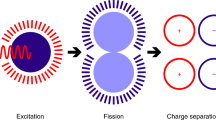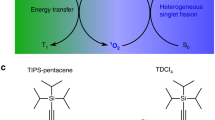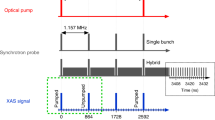Abstract
Silicon dominates contemporary solar cell technologies1. But when absorbing photons, silicon (like other semiconductors) wastes energy in excess of its bandgap2. Reducing these thermalization losses and enabling better sensitivity to light is possible by sensitizing the silicon solar cell using singlet exciton fission, in which two excited states with triplet spin character (triplet excitons) are generated from a photoexcited state of higher energy with singlet spin character (a singlet exciton)3,4,5. Singlet exciton fission in the molecular semiconductor tetracene is known to generate triplet excitons that are energetically matched to the silicon bandgap6,7,8. When the triplet excitons are transferred to silicon they create additional electron–hole pairs, promising to increase cell efficiencies from the single-junction limit of 29 per cent to as high as 35 per cent9. Here we reduce the thickness of the protective hafnium oxynitride layer at the surface of a silicon solar cell to just eight angstroms, using electric-field-effect passivation to enable the efficient energy transfer of the triplet excitons formed in the tetracene. The maximum combined yield of the fission in tetracene and the energy transfer to silicon is around 133 per cent, establishing the potential of singlet exciton fission to increase the efficiencies of silicon solar cells and reduce the cost of the energy that they generate.
This is a preview of subscription content, access via your institution
Access options
Access Nature and 54 other Nature Portfolio journals
Get Nature+, our best-value online-access subscription
$29.99 / 30 days
cancel any time
Subscribe to this journal
Receive 51 print issues and online access
$199.00 per year
only $3.90 per issue
Buy this article
- Purchase on Springer Link
- Instant access to full article PDF
Prices may be subject to local taxes which are calculated during checkout





Similar content being viewed by others
Data availability
The data that support the findings of this study are available from the corresponding author upon reasonable request.
Code availability
The custom code that supports the findings of this study is available from the corresponding author upon reasonable request.
References
Green, A. M. Commercial progress and challenges for photovoltaics. Nat. Energy 1, 15015 (2016).
Shockley, W. & Queisser, H. J. Detailed balance limit of efficiency of p–n junction solar cells. J. Appl. Phys. 32, 510–519 (1961).
Smith, M. B. & Michl, J. Singlet fission. Chem. Rev. 110, 6891–6936 (2010).
Smith, M. B. & Michl, J. Recent advances in singlet fission. Annu. Rev. Phys. Chem. 64, 361–386 (2013).
Yost, S. R. et al. A transferable model for singlet-fission kinetics. Nat. Chem. 6, 492–497 (2014); corrigendum 6, 649 (2014).
Dexter, D. L. Two ideas on energy transfer phenomena: ion-pair effects involving the OH stretching mode, and sensitization of photovoltaic cells. J. Lumin. 18–19, 779–784 (1979).
Congreve, D. N. et al. External quantum efficiency above 100% in a singlet-exciton-fission-based organic photovoltaic cell. Science 340, 334–337 (2013).
Wu, T. C. et al. Singlet fission efficiency in tetracene-based organic solar cells. Appl. Phys. Lett. 104, 193901 (2014).
Rao, A. & Friend, R. H. Harnessing singlet exciton fission to break the Shockley–Queisser limit. Nat. Rev. Mater. 2, 17063 (2017).
Hanna, M. C. & Nozik, A. J. Solar conversion efficiency of photovoltaic and photoelectrolysis cells with carrier multiplication absorbers. J. Appl. Phys. 100, 074510 (2006).
Swenberg, C. E. & Stacy, W. T. Bimolecular radiationless transitions in crystalline tetracene. Chem. Phys. Lett. 2, 327–328 (1968).
Burdett, J. J., Gosztola, D. & Bardeen, C. J. The dependence of singlet exciton relaxation on excitation density and temperature in polycrystalline tetracene thin films: kinetic evidence for a dark intermediate state and implications for singlet fission. J. Chem. Phys. 135, 214508 (2011).
Tabachnyk, M. et al. Resonant energy transfer of triplet excitons from pentacene to PbSe nanocrystals. Nat. Mater. 13, 1033–1038 (2014).
Thompson, N. J. et al. Energy harvesting of non-emissive triplet excitons in tetracene by emissive PbS nanocrystals. Nat. Mater. 13, 1039–1043 (2014).
MacQueen, R. W. et al. Crystalline silicon solar cells with tetracene interlayers: the path to silicon-singlet fission heterojunction devices. Mater. Horiz. 5, 1065–1075 (2018).
Hayashi, T., Castner, T. G. & Boyd, R. W. Quenching of molecular fluorescence near the surface of a semiconductor. Chem. Phys. Lett. 94, 461–466 (1983).
Piland, G. B. et al. Dynamics of molecular excitons near a semiconductor surface studied by fluorescence quenching of polycrystalline tetracene on silicon. Chem. Phys. Lett. 601, 33–38 (2014).
Bonilla, R. S., Hoex, B., Hamer, P. & Wilshaw, P. R. Dielectric surface passivation for silicon solar cells: a review. Phys. Status Solidi A 214, 1700293 (2017).
Aberle, A. G. Surface passivation of crystalline silicon solar cells: a review. Prog. Photovolt. Res. Appl. 8, 473–487 (2000).
Becker, J. S., Kim, E. & Gordon, R. G. Atomic layer deposition of insulating hafnium and zirconium nitrides. Chem. Mater. 16, 3497–3501 (2004).
Um, H.-D. et al. Dopant-free all-back-contact Si nanohole solar cells using MoOx and LiF films. Nano Lett. 16, 981–987 (2016).
Sinton, R. A. & Cuevas, A. Contactless determination of current–voltage characteristics and minority-carrier lifetimes in semiconductors from quasi-steady-state photoconductance data. Appl. Phys. Lett. 69, 2510–2512 (1996).
Geacintov, N., Pope, M. & Vogel, F. Effect of magnetic field on the fluorescence of tetracene crystals: exciton fission. Phys. Rev. Lett. 22, 593–596 (1969).
Merrifield, R. E., Avakian, P. & Groff, R. P. Fission of singlet excitons into pairs of triplet excitons in tetracene crystals. Chem. Phys. Lett. 3, 386–388 (1969).
Suna, A. Kinematics of exciton–exciton annihilation in molecular crystals. Phys. Rev. B 1, 1716–1739 (1970).
Dexter, D. L. A theory of sensitized luminescence in solids. J. Chem. Phys. 21, 836–850 (1953).
Mata, A., Fleischman, A. J. & Roy, S. Characterization of polydimethylsiloxane (PDMS) properties for biomedical micro/nanosystems. Biomed. Microdevices 7, 281–293 (2005).
Kim, Y.-K., Kim, G. T. & Ha, J. S. Simple patterning via adhesion between a buffered-oxide etchant-treated PDMS stamp and a SiO2 substrate. Adv. Funct. Mater. 17, 2125–2132 (2007).
Wu, C. I., Hirose, Y., Sirringhaus, H. & Kahn, A. Electron–hole interaction energy in the organic molecular semiconductor PTCDA. Chem. Phys. Lett. 272, 43–47 (1997).
Acknowledgements
This work was supported through the Center for Excitonics, an Energy Frontier Research Center, by the US Department of Energy, Office of Science, Office of Basic Energy Sciences under award number DE-SC0001088 (MIT). Surface characterization work at Princeton was supported in part by the U.S. Department of Energy, Office of Basic Energy Sciences, Division of Materials Sciences and Engineering under award DE-SC0012458 (A.K.) and the National Science Foundation Graduate Research Fellowship grant DGE-1656466 (H.L.S.). We thank T. Buonassisi for access to the silicon lifetime and wafer metrology system. We thank D.-G. Ha for help with the atomic force microscopy measurements.
Peer review information
Nature thanks Akshay Rao and the other anonymous reviewer(s) for their contribution to the peer review of this work.
Author information
Authors and Affiliations
Contributions
M.E. and T.W. fabricated the photoluminescent samples and measured the photoluminescent excitation spectra and the effect of the magnetic field on photoluminescence. M.E., T.W. and C.F.P. built the setup for the measurements of the effect of the magnetic field on photoluminescence. J.F.K. and M.E. fabricated the solar cells. M.E. and J.F.K. performed solar cell measurements (current–voltage and EQE measurements, and measurements of the effects of the magnetic field). M.E., L.N. and S.W. performed the photoconductance decay measurements. H.L.S. performed the ultraviolet photoelectron spectroscopy and inverse photoemission spectroscopy measurements. H.L.S. and M.E. performed the X-ray photoelectron spectroscopy measurements. M.A.B., M.E., D.N.C. and T.W. conceived the project. A.K., M.G.B. and M.A.B. supervised the experiments. All authors discussed the results and commented on the manuscript.
Corresponding author
Ethics declarations
Competing interests
MIT has filed a provisional application for a US patent based on this technology that names M.E., T.W. and M.A.B. as inventors (serial number 62/678,818).
Additional information
Publisher’s note: Springer Nature remains neutral with regard to jurisdictional claims in published maps and institutional affiliations.
Extended data figures and tables
Extended Data Fig. 1 Atomic force microscopy data of HfOxNy (8 Å, five atomic layer deposition cycles) on silicon.
The film quality was monitored using atomic force microscopy (Veeco Metrology Nanoscope V 3100 SPM; tip, HQ:NSC14/AL BS). The film thickness was monitored using ellipsometry (J. A. Woollam VASE ellipsometer). 500 cycles correspond to a thickness of 83 nm. RMS, root mean square.
Extended Data Fig. 2 Fabrication process of singlet-fission-enhanced silicon solar cells.
Steps 1–14 are based on a previous work21. BOE, buffered oxide etch. RT, room temperature. ALD, atomic layer deposition; IPA, isopropylalcohol; NR9-1000PY; negative-tone photoresist designed for 365 nm wavelength exposure; RD6, resist developer; SC1, RCA standard clean 1; SC2, RCA standard clean 2; PV, photovoltaic cell; p-Si, boron-doped silicon.
Extended Data Fig. 3 Short-wavelength infrared EQE spectra for a tetracene-coated silicon solar cell (silicon–8-Å HfOxNy–30 nm tetracene) and a silicon solar cell without tetracene (silicon–10 nm aluminium oxide).
Devices are fabricated using the procedures described in Methods and show increases in EQE at long wavelengths, potentially due to poor carrier collection from the front of the cell. We note that in the absence of tetracene, there is ineffective thin-HfOxNy passivation. Silicon–8-Å-HfOxNy devices generate negligible photocurrent, in agreement with our measurements of the surface recombination velocity in the absence of tetracene. Tc, tetracene.
Extended Data Fig. 4 Silicon photoluminescence (PL) spectrum corresponding to the band-to-band transition.
The peak is at 1,144 nm (1.1 eV).
Extended Data Fig. 5 Degradation for wavelength sweeps in the excitation spectrum.
Arrows indicate the direction of the wavelength sweep (from short to long wavelengths or vice versa). The time t indicates the start time of the sweep relative to the start of the entire measurement. a.u., arbitrary units.
Extended Data Fig. 6 Dependence of the change in photoluminescence from the applied magnetic field on the optical intensity (pump power density).
Exciting the sample with vastly different intensities (left, 8.2 mW cm−2 and right, 933 mW cm−2) yields a similar effect on the change in photoluminescence (−4.7% and −4.2%, respectively). Error bars are 1σ; n = 4,000.
Extended Data Fig. 7 Bichromatic experiments with different probe beam wavelengths.
The choice of the second pump wavelength (left, 785 nm; right, 632.8 nm) has no influence on the change in photoluminescence from the application of the magnetic field (about −2.0% for both secondary wavelengths). This excludes the possibility that any effects resulting from the choice of the second pump beam impair our determination of the exciton yield. The ratio of the flux density is calculated by comparing the number of incident photons per second from the two pump beams. The photon flux density of the 785 nm beam is 35 times larger than that of the 532 nm beam and the photon flux density of the 632.8 nm beam is 27 times larger than that of the 532 nm beam. Error bars are 1σ; n = 4,000.
Extended Data Fig. 8 Beam alignment for the bichromatic experiment with the second probe at 632.8 nm.
The green beam (Genesis, 532 nm) influences the surface properties through passivation, and so must cover the same area or a larger area than the red beam (Thorlabs HeNe, 632.8 nm). CCD, charge-coupled device.
Extended Data Fig. 9 Beam alignment for the bichromatic experiment with the second probe at 785 nm.
The green beam (Genesis, 532 nm) influences the surface properties through passivation, and so must cover the same or a larger area than the red beam (Thorlabs photodiode, 785 nm).
Extended Data Fig. 10 Back protection using PDMS.
During device fabrication, we protect the back contacts using PDMS and an encapsulating piece of silicon to provide a seal during the front-side cleaning step. Here we show that the presence of PDMS on the back side can corrupt the integrity of the front surface. A full RCA clean of the front surface at 80 °C shows no change in photoluminescence under an applied magnetic field. Using a milder version of the clean at 60 °C partly alleviates the issue but the change in photoluminescence from the applied magnetic field is not as large as in the samples processed without PDMS (see Fig. 5).
Supplementary information
Supplementary Information
This file contains Supplementary Information Sections A-H, including Supplementary Figs. 1-19 and Supplementary Tables 1-3, which characterize the materials, devices, and experimental methods employed, as well as a derivation of the calculation of energy transfer efficiency based on the magnetic field dependence of singlet exciton fission.
Rights and permissions
About this article
Cite this article
Einzinger, M., Wu, T., Kompalla, J.F. et al. Sensitization of silicon by singlet exciton fission in tetracene. Nature 571, 90–94 (2019). https://doi.org/10.1038/s41586-019-1339-4
Received:
Accepted:
Published:
Issue Date:
DOI: https://doi.org/10.1038/s41586-019-1339-4
This article is cited by
-
Quintet formation, exchange fluctuations, and the role of stochastic resonance in singlet fission
Communications Physics (2023)
-
Promoting multiexciton interactions in singlet fission and triplet fusion upconversion dendrimers
Nature Communications (2023)
-
Orbital-resolved observation of singlet fission
Nature (2023)
-
Elusive excited states identified from cutting-edge molecular movies
Nature (2023)
-
Machine-learning assisted design principle search for singlet fission: an example study of cibalackrot
npj Computational Materials (2022)
Comments
By submitting a comment you agree to abide by our Terms and Community Guidelines. If you find something abusive or that does not comply with our terms or guidelines please flag it as inappropriate.



